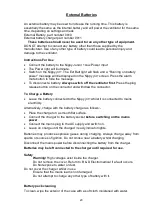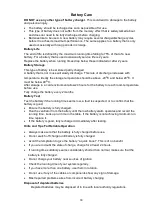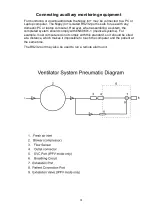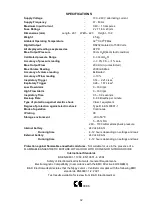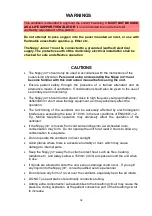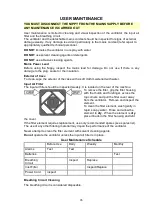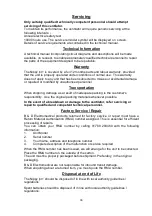
25
Alarm Conditions/Tests
Test the alarms prior to use or daily for machines that are in constant use.
Before testing alarms, ensure that the alarm is not muted. To cancel the Mute,
press and hold the mute switch until a beep is heard (2 seconds).
High Flow Alarm
If the inspiratory flow exceeds the high alarm value, the alarm will be activated
accompanied by the on-screen, high flow alarm message.
To Test
Disconnect the breathing circuit at the patient outlet port and allow the
flow to exceed the set alarm value. The alarm will be activated after a delay of 5
seconds, accompanied by the on-screen, high flow alarm message.
Disconnect Alarm
If the breathing circuit becomes disconnected, the alarm will be activated.
To Test
Switch on the ventilator and cancel the Mute. Disconnect the breathing
circuit at the patient outlet port. The High Flow alarm will be activated after a delay of
5 seconds and will be replaced by the disconnect alarm after 10 seconds,
accompanied by the on-screen disconnect alarm message.
Low Flow Alarm
The low flow alarm warns of insufficient inspiratory flow. This could be caused by a
blockage in the patients’ airway or breathing circuit. The resulting drop in flow will
activate the alarm.
To Test
Switch on the ventilator and cancel the Mute. Occlude the outlet and
wait 10 seconds. The alarm will sound, accompanied by the low flow alarm message
and the flow display will turn red.
Power Fail Alarm
If both mains and internal power to the Nippy jnr+ fails, the alarm will operate and
continue for approx. 5 minutes. Press the mute button to silence the alarm.
To Test
Machines NOT fitted with an internal battery - start the Nippy jnr+ and
switch off the mains power at the wall socket. The screen will go blank after a few
seconds and the alarm will sound. Press the mute switch or restore the power and
re-start the ventilator to silence.
Machines fitted with internal battery – Power fail alarm will only operate if the internal
battery is completely discharged and the mains fails. The only way to test it is to run
the ventilator on battery power until the battery is exhausted and the power fails.
High Pressure Alarm
If the airway pressure exceeds 120% of the IPAP setting for more than 2 seconds,
the alarm will sound and the pressure display will turn red.
It is not possible for the user to test this function.
Fault Alarms
The fault alarm indicates a fault in the machine. The on-screen message will indicate
the nature of the fault. The message may be temporarily hidden by pressing the
Mute button.
It is not possible for the user to test this function.
If you receive a fault message at any time, DO NOT continue to use the
ventilator. The machine MUST be referred to suitably qualified technical
personnel for investigation/repair.



















